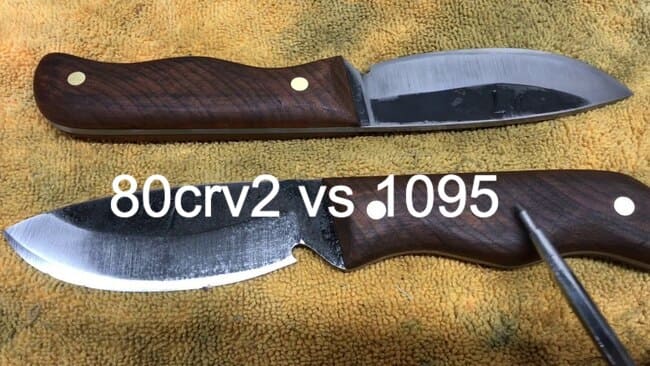When it comes to choosing the right steel for knives, there are numerous options available, each with its own set of characteristics. In this blog post, we will make a in-depth comparison between two popular knife steels:
- 80CrV2 and
- 1095.
Both steels have their unique properties and are highly regarded among knife enthusiasts. By understanding the differences and similarities between 80CrV2 and 1095, you can make an informed decision when selecting the ideal steel for your next knife project.
Overview of 80CrV2
80CrV2 is a high-carbon tool steel known for its outstanding toughness and wear resistance. It contains significant amounts of carbon (0.75% – 0.85%), chromium (0.40% – 0.60%), and vanadium (0.15% – 0.30%).
The added chromium contributes to its corrosion resistance, while vanadium enhances toughness and edge retention.
With a hardness of around 58-60 HRC after proper heat treatment, 80CrV2 is suitable for heavy-duty applications and offers excellent performance in terms of edge retention and durability.
Overview of 1095
1095 is a simple, non-stainless high-carbon steel known for its exceptional hardness and edge retention. It contains approximately 0.90% – 1.03% carbon, making it one of the highest carbon content steels commonly used in knife making.
1095 steel is renowned for its ability to achieve and maintain an incredibly sharp edge. However, it is important to note that 1095 steel lacks the corrosion resistance of stainless steels and requires proper care to prevent rusting.
80CRV2 vs 1095

| Aspect | 80CRV2 | 1095 |
|---|---|---|
| Chemical Composition | 0.8% Carbon, 0.5% Chromium, 0.4% Manganese, 0.2% Vanadium, 0.25% Silicon | 0.9% Carbon, 0.3% Manganese, 0.04% Sulfur, 0.035% Phosphorus, 0.15% Silicon |
| Hardness | 57-58 HRC | 55-57 HRC |
| Toughness | Average | Decent |
| Wear Resistance | High | Good |
| Edge Retention | Good | Moderate |
| Corrosion Resistance | Limited | Limited |
| Ease of Sharpening | Easy | Easy |
| Cost | Affordable | Affordable |
80CrV2 and 1095 steels: Comparing the Properties
Hardness
Both 80CrV2 and 1095 steels can achieve high levels of hardness. 80CrV2 typically reaches a hardness of 58-60 HRC, while 1095 can range from 55-58 HRC.
The slightly higher hardness of 80CrV2 may provide better wear resistance, but it can also make the steel slightly more prone to chipping.
Toughness
80CrV2 exhibits excellent toughness, which allows it to withstand heavy impacts and resist deformation. This makes it suitable for applications that require a robust and durable blade.
On the other hand, while 1095 is not as tough as 80CrV2, it still offers good toughness and can withstand moderate use without chipping or fracturing.
Corrosion Resistance
One notable difference between the two steels is their corrosion resistance. 80CrV2 contains chromium, which imparts some corrosion resistance, although it is not considered a stainless steel.
In contrast, 1095 lacks any significant alloying elements for corrosion resistance and is more prone to rusting. Proper care and maintenance, such as regular oiling and drying, are crucial to prevent rust on knives made from 1095 steel.
1095 exhibits slightly better resistance to corrosion compared to 80CrV2. This implies that 1095 is relatively more capable of withstanding rust and tarnishing when compared to 80CrV2.
Edge Retention
Both steels offer impressive edge retention, but the choice depends on the intended use of the knife. 1095 steel, with its high carbon content, excels in achieving and maintaining a razor-sharp edge.
It is favored for slicing tasks that require precision. 80CrV2, with the addition of vanadium, also provides excellent edge retention while offering enhanced toughness for more demanding applications.
Conclusion
Choosing between 80CrV2 and 1095 knife steels ultimately depends on your specific needs and preferences. If you prioritize excellent toughness, wear resistance, and corrosion resistance, 80CrV2 may be the ideal choice.
On the other hand, if you desire exceptional hardness, edge retention, and ease of sharpening, 1095 might be more suitable.
